LoWMob: Intra-PAN Mobility Support Schemes for 6LoWPAN
Abstract
:1. Introduction
2. Related Work
3. Possible Mobility Scenarios in 6LoWPAN
- Intra-PAN mobility: When a MN moves within a PAN, Intra-PAN mobility occurs. In Figure 1, this kind of mobility occurs when a patient moves within a room.
- Inter-PAN mobility: This kind of mobility occurs when a MN moves from one PAN to another. For example, in Figure 1, a patient moves from one room to the other, where each room hosts one PAN.
- WPAN mobility: In this case, the whole PAN changes its point of attachment. This case is similar to NEMO.
- Providing fast handoff detection.
- The MNs should be addressable by any CN, irrespective of its whereabouts.
- The signaling is also required to be minimized by considering the resource constraint characteristic of the LoWPAN devices.
- Reduced Function Devices (RFDs) should be kept out of the mobility-related signaling.
4. System Model and Assumptions
- A PAN consists of several SNs, which are Full Functional Devices (FFDs) and a PAN coordinator, i.e., the GW. Multiple GWs/PANs can also be considered to improve the reliability and scalability. However, in this paper, we limit our scope for a network having single PAN coordinator.
- The nodes at the periphery of the PAN are known as Border Nodes (BNs). These are FFDs which are mostly in quasi-sleep state. In quasi-sleep state, the node’s sensor is turned on, whereas its transceiver is turned off.
- A MN is an FFD or RFD which moves within a PAN. A MN is assumed to transmit or receive data packets periodically, i.e., if a MN does not transmit or receive data packet within MST (Maximum Sleep Time), it is assumed to be dead.
- The SNs spend most of their time in the sleep state.
- A MN is an active device which moves within a PAN. It can be a FFD or a RFD.
- The SNs are densely deployed to an extent that their transmission ranges overlap.
- Each 6loWPAN device has the same transmission signal strength and receiver sensitivity.
- Each SN measures the distance between itself and the MN based on the Received Signal Strength Indication (RSSI) [18].
- Each SN is equipped with a radio-triggered hardware component that activates sensors from/to the sleep state, by sending a special wake up radio signal [19].
- 6LoWPAN networks provide two types of addresses, IEEE EUI 64-bits extended address, and 16-bits short addresses. The SNs are assigned with IPv6 and 16 bits short address [20].
- The MN is assigned with a 16 bits short address, which is unique within a PAN, and remains fixed irrespective of its location within the PAN. The IP address of the MN also remains fixed irrespective of its mobility within the PAN.
- The interoperability between IPv6 domain and the IEEE802.15.4 device is handled by the adaptation layer [20].
- Each SN is equipped with an antenna array in order to obtain the Angle of Arrival (AoA) measurements.
- Any of the MAC protocols, synchronous or asynchronous, can be used to ensure the reliability and routing of packets in duty cycle WSN.
5. LoWMob Mobility Support Scheme
5.1. New MN Joining the PAN
5.2. Handoff Support
5.3. Proposed Message Formats
5.3.1. Location Update Message Format
5.3.2. Message Format of a Data Packet Sent from a MN to the CNs
5.3.3. Message Format of a Data Packet Sent from a CN to the MN
6. Distributed LoWMob (DLoWMob) Mobility Support Scheme
6.1. The Handoff Process in DLoWMob
6.2. Route Optimization for Intra-PAN Communication in DLoWMob
6.2.1. Routing of MN’s Packet in a Route Optimized Environment
6.2.2. Handoff Process in the Route Optimization Scheme
7. Security Considerations for Proposed Mobility Schemes
- In order to establish an individual key shared between the GW and a node, and a pairwise key shared between a node and each of its intermediate one hop neighbors, we can use LEAP [22]. In the proposed scheme, the MSPs share an individual key with the GW and pairwise key with each of its intermediate MSP. The SNs also share pairwise key with another SN and an individual key with the GW. It should be noted that both individual key and pairwise key are symmetric keys.
- G: The gateway (GW) which is assumed to be trusted [23].
- MSPi, MSPj: Two intermediate neighboring MSPs located in a path between a source MN and a destination MN.
- Kij: A symmetric pair-wise shared key between MSPi and MSPj
- Ks: Session key shared between source and destination MN.
- Kig: Individual shared key between MSPi and the GW.
- Km: Mobile Key between MN and its future SNs
- Kc: Communication key which is shared between a MN and the GW.
- M1|M2: The concatenation of messages M1 and M2
- {M}<Kij ,C>: The encryption of message M, with key Kij and the incremental counter C [24].
- KMH: The key shared between MN and its HA.
- KSP: The key shared between SN and its MSP.
- KSG: The key shared between SN and GW.
- MAC (Kij, M): The message authentication code (MAC) of message M, with the symmetric secret key Kij
7.1. Authentication of LU
7.2. Authentication of the MN before It Is Allowed to Join the PAN
7.3. Mutual Authentication of MN and its Future SNs
7.4. Securing MN’s Data Packets
7.5. Authentication of Messages that Modify a MN’s Routing Entry in the MSPs
8. Performance Evaluation
8.1. End to End Delay and Packet Success Ratio
8.2. Handoff Overhead
- A domain is composed of N equal squares that are equal in size and form a contiguous area.
- The MNs are moving with an average speed of v, and the direction of their movement is between 0 to 2π.
- MN moves out of the PAN within K finite movements
- The cost incurred in sending LU messages to the GW, and the cost of sending new_node messages when a MN associates with a new SN.
- The cost incurred in tunneling data packets from the GW to the SNs, for the destination MN. The default parameter values for calculation of LU and tunneling cost are given in Table 2.
8.2.1. Location Update Cost
8.2.2. Tunneling Cost
8.2.2.1. Location Update Signaling Cost
8.2.2.2. Tunneling Cost versus Packet Arrival Rate
9. Conclusions
Acknowledgments
References
- Wireless Medium Access Control and Physical Layer Specifications for Low-Rate Wireless Personal Area Networks; 802.15.4-2003; IEEE Standard, September 2006.
- IPv6 over Low Power WPAN (Active WG). http://tools.ietf.org/wg/6lowpan.
- Shin, M.; Camilo, T.; Silva, J.; Kaspar, D. Internet-Draft- 6lowpan-mobility; Internet-Draft, 14-Nov 2007 (work in progress).
- Soliman, H.; Castelluccia, C.; Malki, K.E.; Bellier, L. Hierarchical MIPv6 Mobility Management, RFC 4140. August 2005.
- Saha, D.; Mukherjee, A.; Misra, I.S.; Chakraborty, M. Mobility Support in IP: A Survey of Related Protocols. IEEE Network 2004, 18, 34–40. [Google Scholar]
- Akyildiz, I.F.; Xie, J.; Mohanty, S. A Survey of Mobility Management in Next-Generation All-IP-Based Wireless Systems. IEEE Wirel. Commun 2004, 11, 16–28. [Google Scholar]
- Ramjee, R.; La Porta, T.; Thuel, S.; Varadhan, K.; Wang, S. HAWAII: A Domain Based Approach for Supporting Mobility in Wide Area Wireless Area Networks. In Seventh International Conference on Network Protocols; Toronto, Canada, 1999; pp. 283–292. [Google Scholar]
- Devarapalli, V.; Wakikawa, R.; Petrescu, A.; Thubert, P. Network Mobility (NEMO) LoWMob Support Protocol, RFC 3936 2005.
- Gundavevelli, S.; Leung, K.; Devrapalli, V.; Chowdhury, K.; Patil, B. Proxy Mobile IPv6 2008.
- Istepanian, R.; Jovanov, E.; Zhang, Y. Guest Editorial Introduction to the Special Section on M-Health: Beyond Seamless Mobility and Global Wireless Health-care connectivity. IEEE Trans. Inf Technol Biomed 2004, 8, 405–414. [Google Scholar]
- Ni, X.; Shi, W.; Ni, X.; Zheng, S. Design of Micro Mobility Support in Bluetooth Sensor Networks. IEEE International Conference on Industrial Informatics, Singapore, 16–18 August 2006; pp. 150–154.
- Kim, J.H.; Hong, C.S.; Okamura, K. A Routing Scheme for Supporting Network Mobility of Sensor Network Based on 6LoWPAN. In Managing Next Generation Networks and Services; Springer Verlag: Berlin-Heidelberg, Germany, 2007; Volume 4773, pp. 155–164. [Google Scholar]
- Kempf, J. Problem Statement for Network - Based Localized Mobility Management, RFC 4830. April 2007.
- Wang, H.; Huang, Q.; Xia, Y.; Wu, Y.; Yuan, Y.G. A Network-Based Local Mobility Management Scheme for Wireless Mesh Networks. IEEE Wireless Communications and Networking Conference, Hong Kong, 11–15 March 2007; pp. 3792–3797.
- Bag, G.; Raza, M.T.; Mukhtar, H.; Akbar, A.H.; Shams, S.M.S.; Kim, K.-H.; Yoo, S.-W.; Kim, D.H. Energy-Aware and Bandwidth-Efficient Mobility architecture for 6LoWPAN. IEEE Military Communications Conference, San Diego, USA, 16–19 November 2008; pp. 1–7.
- Bag, G.; Shams, S.M.S.; Akbar, A.H.; Raza, H.M.M.T.; Kim, K.-H.; Yoo, S.-W. Network Assisted Mobility Support for 6LoWPAN. 6th IEEE Consumer Communications and Networking Conference, Las Vegas, USA, 10–13 January 2009; pp. 1–5.
- Bag, G.; Shams, S.M.S.; Mukhtar, H. Inter PAN Mobility Support for 6LoWPAN. Third International Conference on Convergence and Hybrid Information Technology, Busan, Korea, 11–13 November 2008; pp. 787–792.
- Zhang, L.; Cheng, Q.; Wang, Y.; Zeadally, S. A Novel Distributed Sensor Positioning System Using the Dual of Target Tracking. IEEE Trans. Comput 2008, 57, 246–260. [Google Scholar]
- Gu, L.; Stankovic, J.A. Radio-Triggered Wake-Up for Wireless Sensor Networks. In 10th IEEE Real-Time and Embedded Technology and Applications Symposium; Miami, USA, March 2005; pp. 157–182. [Google Scholar]
- Kushalnagar, N.; Montenegro, G.; Hui, J.; Culler, D. 6LoWPAN: Transmission of IPv6 Packets over IEEE 802.15.4 Networks; RFC 4944; September 2007. [Google Scholar]
- Patwari, N.; Ash, J.; Kyperountas, S.; Hero, A.; Moses, R.; Correal, N. Locating the nodes: Cooperative Localization in Wireless Sensor Networks. IEEE Signal Process Mag 2005, 22, 54–69. [Google Scholar]
- Zhu, S.; Setia, S.; Jajodia, S. Leap: Efficient Security Mechanisms for Large scale Distributed Sensor Networks. 10th ACM Conference on Computer and Communications Security, New York, NY, USA, 2003; pp. 62–72.
- Wang, Y.; Attebury, G.; Ramamurthy, B. A Survey of Security Issues in Wireless Sensor Networks. IEEE Commun. Surv. Tutorials 2006, 8, 2–23. [Google Scholar]
- Perrig, A.; Szewczyk, R.; Tygar, J.; Wen, V.; Culler, D. SPINS: Security Protocols for Sensor Networks. Wirel. Netw 2002, 8, 521–534. [Google Scholar]
- Tang, F.; Guo, M.; Li, M.; Wang, C.; Dong, M. Secure Routing for Wireless Mesh Sensor Networks in Pervasive Environments. Int. J. Intell. Control Syst 2007, 12, 293–306. [Google Scholar]
- Harkins, D.; Carrel, D. The Internet Key Exchange; Standard Track, Network Working Group, November 1998. [Google Scholar]
- Soliman, H. Mobile IPv6: Handover Optimizations and Extensions. Mobile IPv6: Mobility in a Wireless Internet 2005, 245–287. [Google Scholar]
- Yoon, J.; Liu, M.; Noble, B. Random Waypoint Considered Harmful. INFOCOM 2003. Twenty-Second Annual Joint Conference of the IEEE Computer and Communications Societies. IEEE, April 2003.
- Mobile Ad Hoc Networks. Available online: http://www.indiastudychannel.com/resources/16156-Mobile-Ad-Hoc-Networks.aspx.
- Buettner, M.; Yee, G.V.; Anderson, E.; Han, R. X-MAC: A Short Preamble MAC Protocol for Duty-Cycled Wireless Sensor Networks. SenSys '06: Proceedings of the 4th International Conference on Embedded Networked Sensor Systems, Colorado, USA, November 2006; pp. 307–320.
- Liu, S.; Fan, K.W.; Sinha, P. CMAC: Energy Efficient MAC Layer Design for Sensor Networks with Anycasting. ACM Trans. Sens. Netw 2009. In press. [Google Scholar]
- Sun, Y.; Gurewitz, O.; Johnson, D. RI-MAC: a receiver-initiated asynchronous duty cycle MAC protocol for dynamic traffic loads in wireless sensor networks. SenSys '08: Proceedings of the 6th ACM Conference on Embedded Network Sensor Systems, Raleigh, USA, November 2008; pp. 1–14.
- Kong, K.; Song, M.; Park, K.; Hwang, C. A Comparative Analysis on the Signaling Load of the Mobile IPv6 and Hierarchical Mobile IPv6: Analytical Approach. IEICE Trans. Inf. Syst 2006, E89-D(1), 139–149. [Google Scholar]
- Song, G.; Zhou, Y.; Ding, F.; Song, A. A Mobile Sensor Network System for Monitoring of Unfriendly Environments. Sensors 2008, 8, 7259–7274. [Google Scholar]

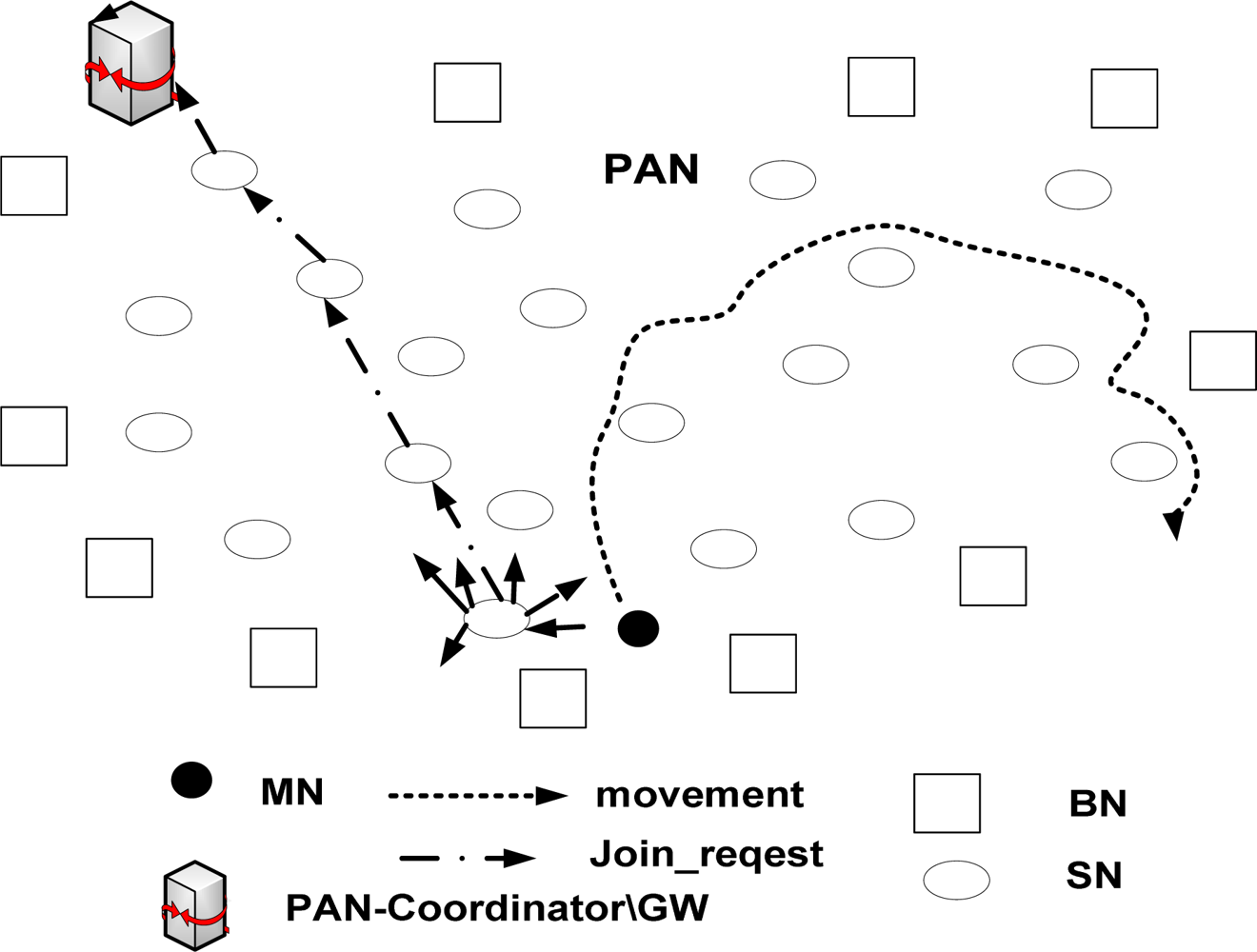
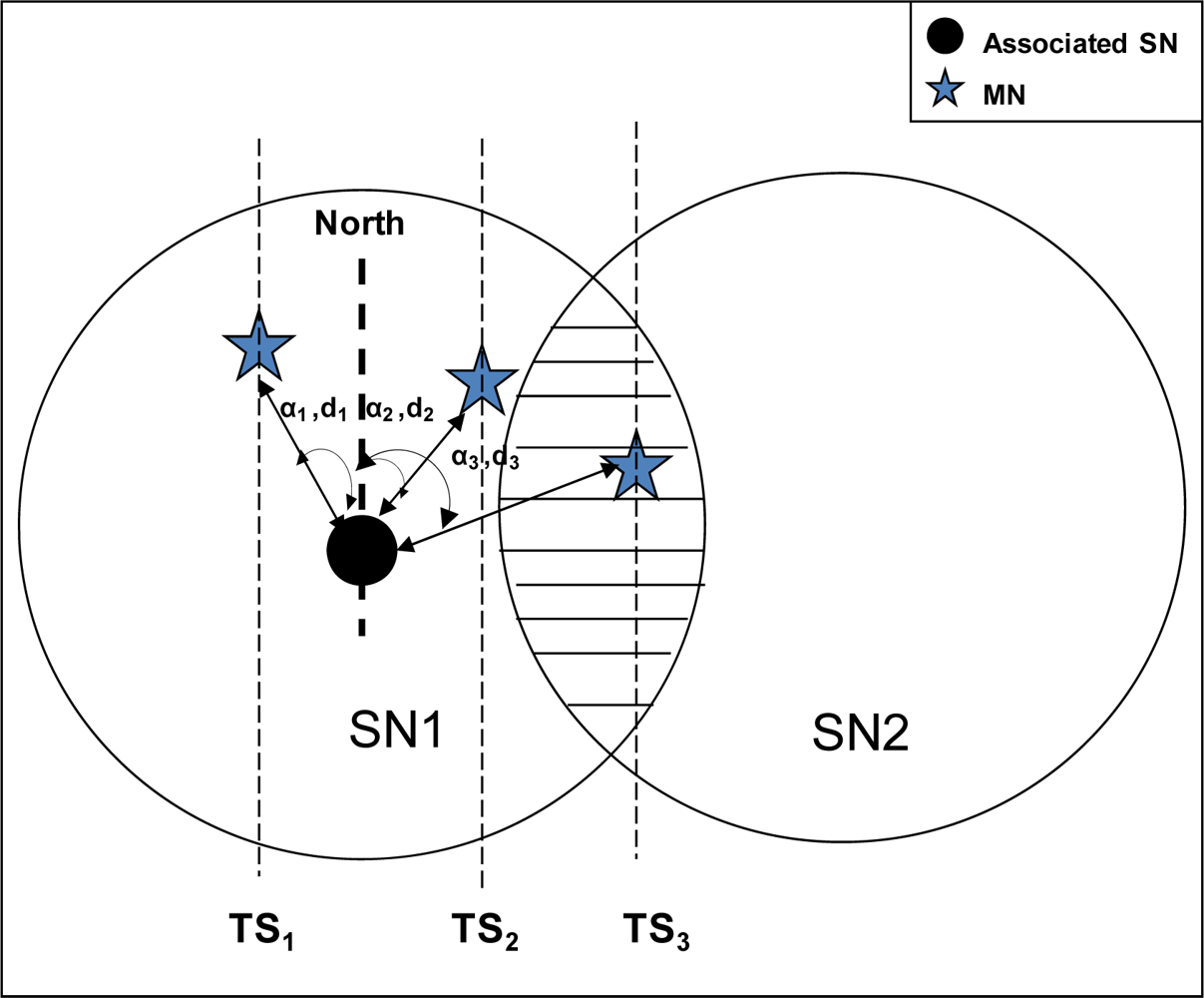
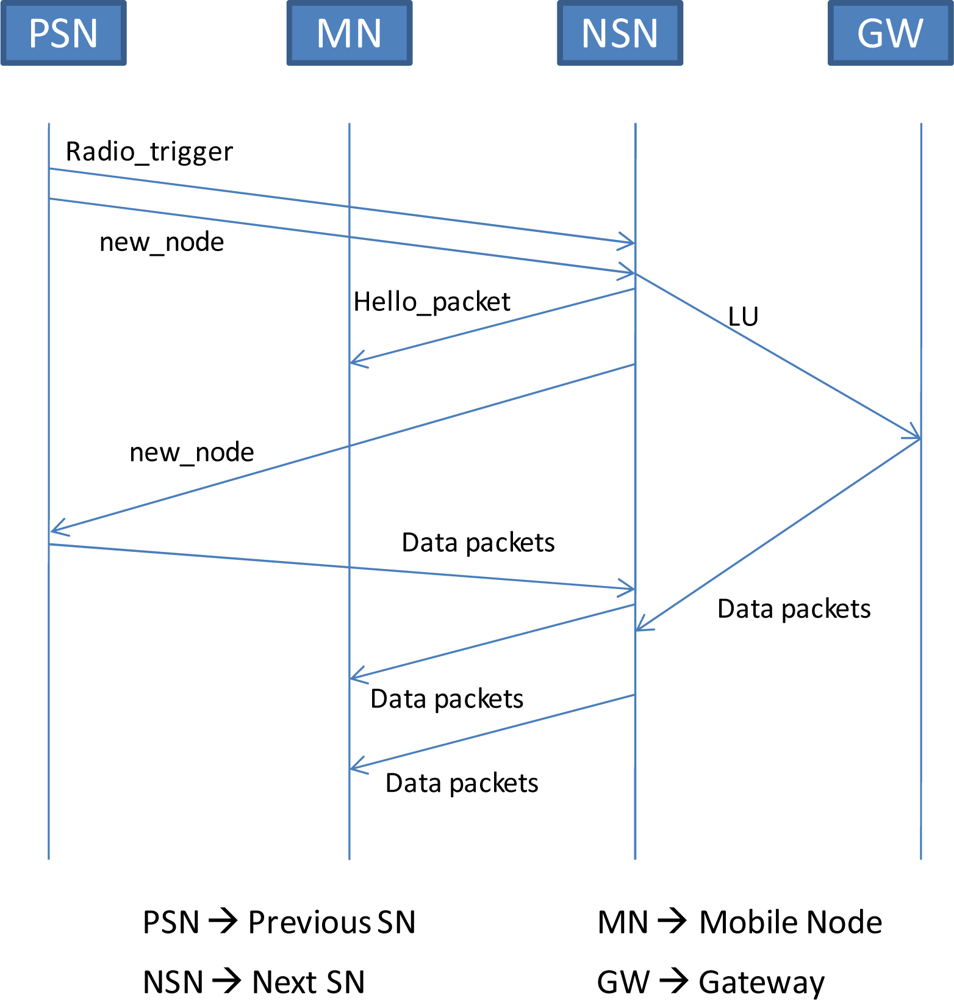
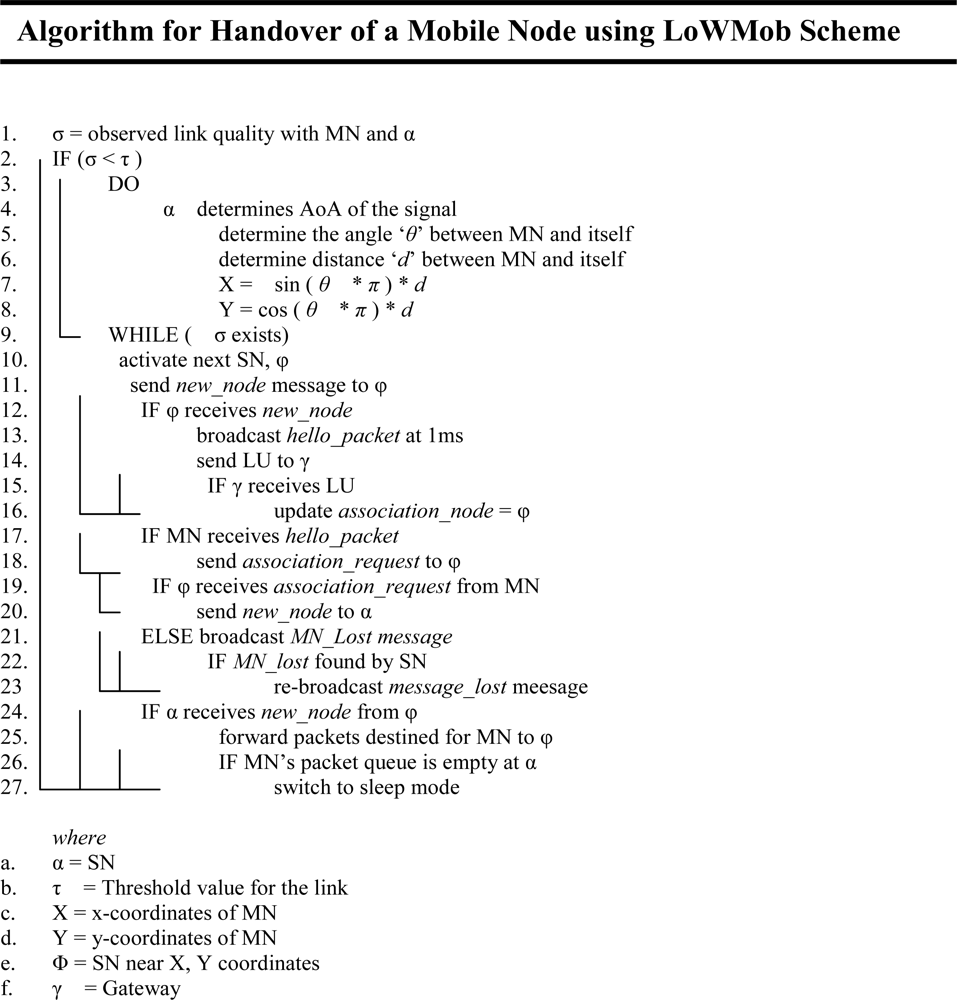




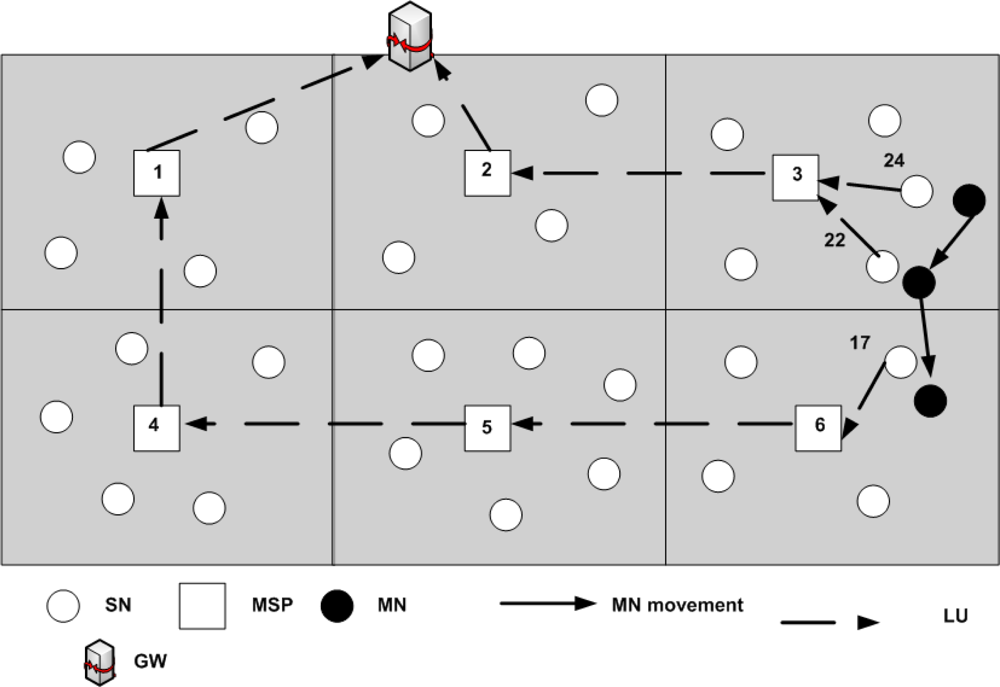


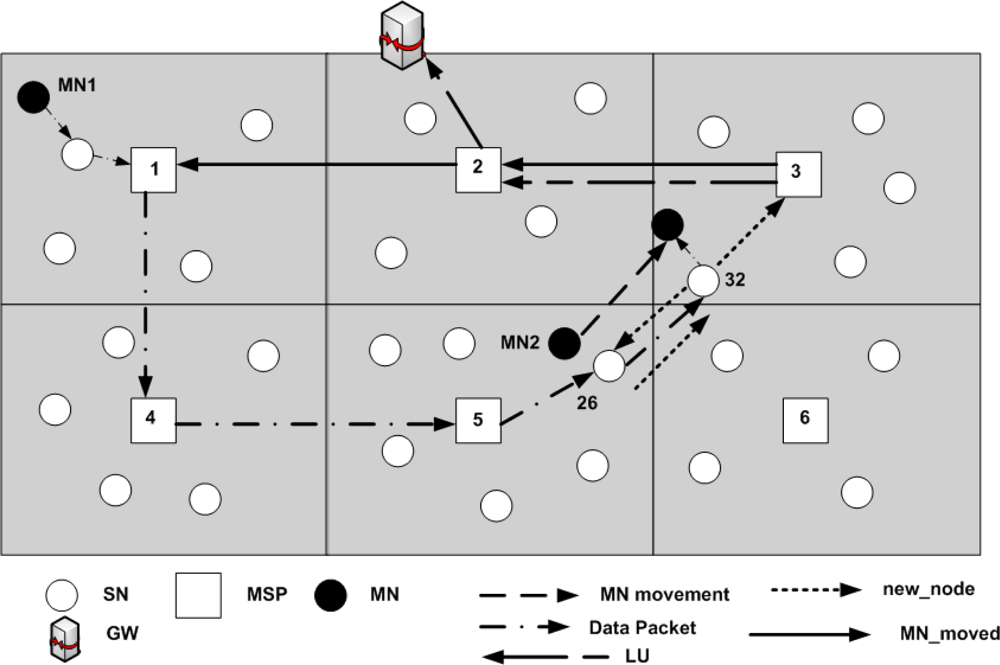





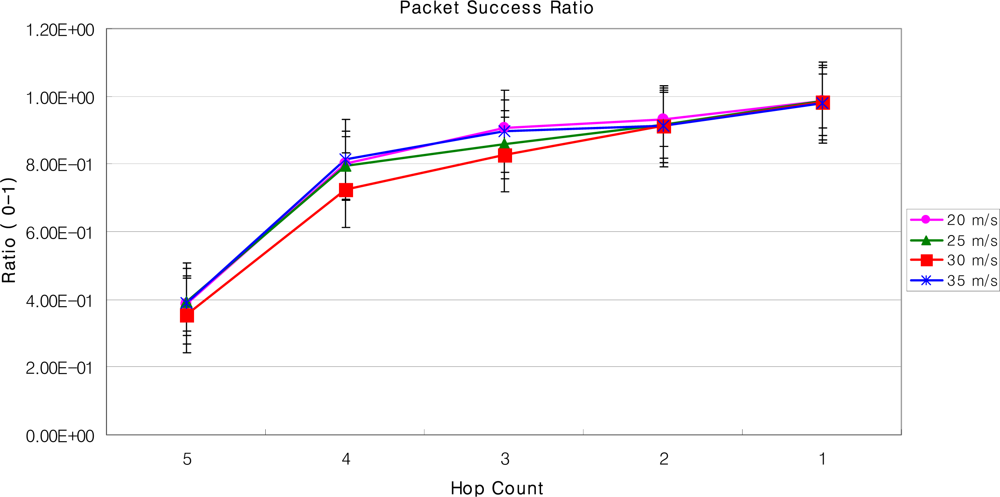



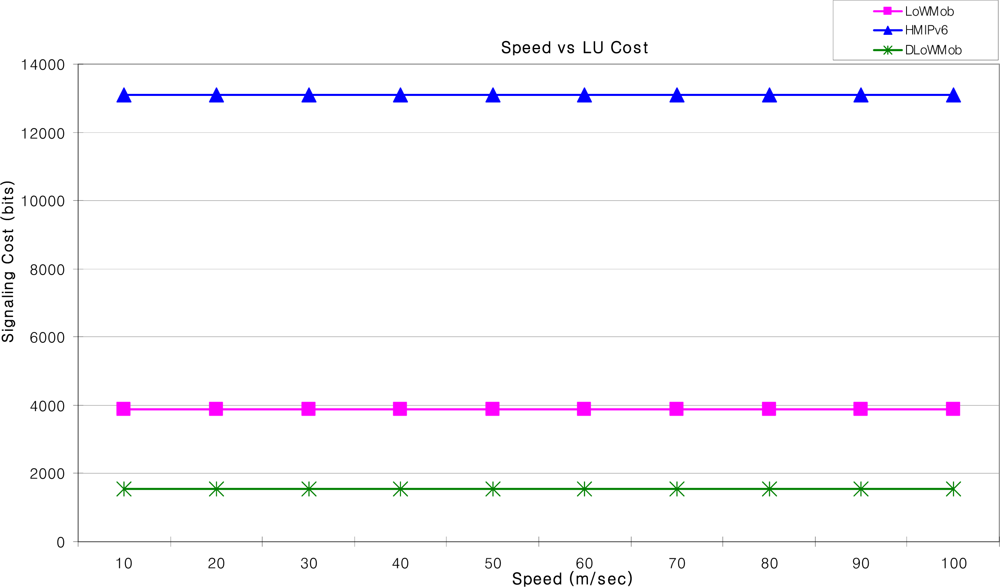
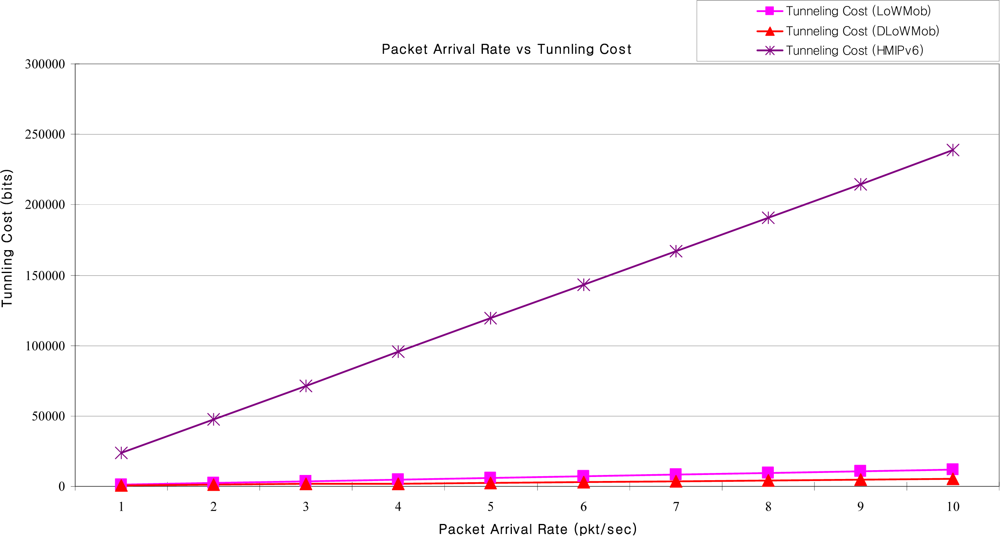
| Dispatch value | Message types |
|---|---|
| 01 000111 | Join_request |
| 01 001011 | Association_request |
| 01 001001 | New_node |
| 01 000110 | GW-MN (Data packet from GW to MN) |
| 01 001111 | MN-GW (Data packet from MN’s associated SN to GW) |
| 01 000111 | LU (Location update packet) |
| 01 010001 | MN-MN (Data packet from source MN to destination MN) |
| Name | Description | Value |
|---|---|---|
| b | LU message cost for one hop | 144 bits |
| t | Tunneling cost in one hop | 16 bits |
| SNW | new_node message cost in one hop | 160 bits |
| NSN | Number of SNs | 36 |
| NMSP | PAN size in terms of number of MSPs | 4 |
| SAR | Area of the Association Range | 900 m2 |
| SD | Area covered by an MSP | 8,100 m2 |
| v | Average speed of MN | 10 m/s |
| μ(K1) | Average number of SNs a MN associates with in a PAN | 2.8 |
| μ(K2) | Average number of MSP a MN associates with in a PAN | 0.999969 |
| L1 | Average number of link hops between GW and SN | 10 |
| L2 | Average number of link hops between GW and MSP | 5 |
| L3 | Average number of link hops between MSP and SN | 1 |
© 2009 by the authors; licensee MDPI, Basel, Switzerland This article is an open access article distributed under the terms and conditions of the Creative Commons Attribution license (http://creativecommons.org/licenses/by/3.0/).
Share and Cite
Bag, G.; Raza, M.T.; Kim, K.-H.; Yoo, S.-W. LoWMob: Intra-PAN Mobility Support Schemes for 6LoWPAN. Sensors 2009, 9, 5844-5877. https://doi.org/10.3390/s90705844
Bag G, Raza MT, Kim K-H, Yoo S-W. LoWMob: Intra-PAN Mobility Support Schemes for 6LoWPAN. Sensors. 2009; 9(7):5844-5877. https://doi.org/10.3390/s90705844
Chicago/Turabian StyleBag, Gargi, Muhammad Taqi Raza, Ki-Hyung Kim, and Seung-Wha Yoo. 2009. "LoWMob: Intra-PAN Mobility Support Schemes for 6LoWPAN" Sensors 9, no. 7: 5844-5877. https://doi.org/10.3390/s90705844
APA StyleBag, G., Raza, M. T., Kim, K.-H., & Yoo, S.-W. (2009). LoWMob: Intra-PAN Mobility Support Schemes for 6LoWPAN. Sensors, 9(7), 5844-5877. https://doi.org/10.3390/s90705844




